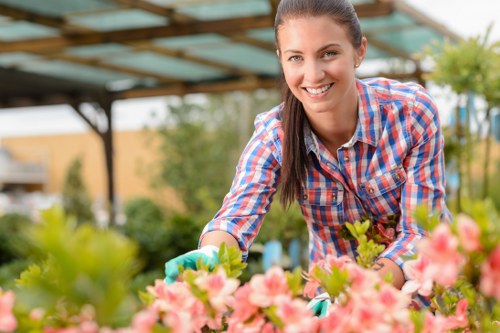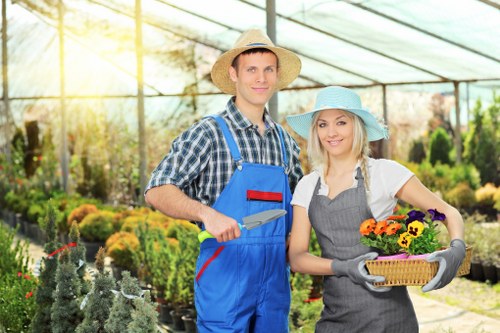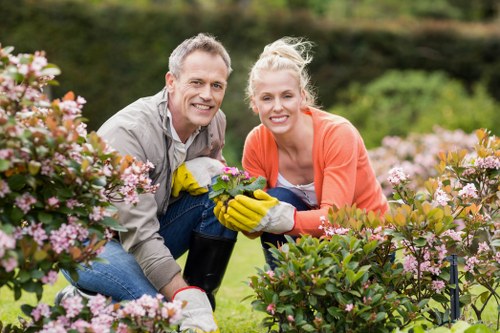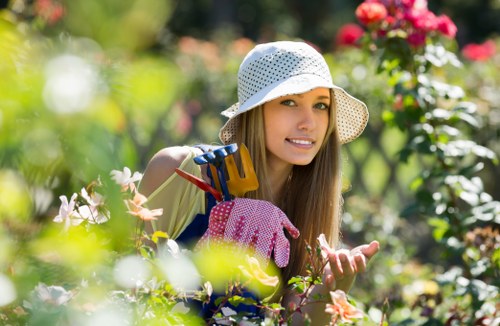Comprehensive Guide to Garden Maintenance in Hainault

Introduction to Garden Maintenance
Gardening is a rewarding pastime that enhances the beauty and value of your property. In Hainault, maintaining a lush and vibrant garden requires specific strategies tailored to the local climate and soil conditions. Whether you are a novice gardener or an experienced green thumb, understanding the fundamentals of garden maintenance in Hainault can help you achieve a thriving outdoor space.
Regular maintenance not only keeps your garden aesthetically pleasing but also ensures the health and longevity of your plants. From weeding and pruning to watering and fertilizing, each task plays a crucial role in the overall success of your garden.
In this article, we will explore the essential aspects of garden maintenance in Hainault, providing you with actionable tips and insights to keep your garden in top condition throughout the year.

Understanding the Local Climate
Hainault experiences a temperate climate with distinct seasonal changes. Understanding these climatic conditions is vital for effective garden maintenance. The region typically enjoys mild winters and warm summers, with moderate rainfall spread throughout the year.
**Key Climate Features of Hainault:
- Average temperatures range from 2°C in winter to 22°C in summer.
- Rainfall is evenly distributed, ensuring adequate moisture for plants.
- Occasional frost in winter can impact sensitive plants.
By aligning your garden maintenance schedule with these climatic patterns, you can better anticipate plant needs and respond to environmental changes effectively.

Soil Preparation and Management
The foundation of a healthy garden lies in well-prepared soil. In Hainault, the soil composition can vary, but it generally tends to be loamy with good drainage. Proper soil management ensures that plants receive the necessary nutrients and support for optimal growth.
Steps for Effective Soil Preparation:
- Soil Testing: Conduct a soil test to determine pH levels and nutrient content.
- Amending the Soil: Add organic matter such as compost or manure to enhance fertility and structure.
- Mulching: Apply mulch to retain moisture, regulate soil temperature, and suppress weeds.
- Aeration: Regularly aerate the soil to improve air circulation and root penetration.
Maintaining the right soil conditions is crucial for the growth of robust and healthy plants. Regularly amend and monitor your soil to keep it in prime condition.

Plant Selection and Placement
Choosing the right plants for your garden is essential for ensuring their success. In Hainault, considering the local climate and soil conditions will help you select species that thrive in the environment.
Tips for Selecting and Placing Plants:
- Native Plants: Opt for native species that are well-adapted to the local climate and require less maintenance.
- Sunlight Requirements: Group plants with similar sunlight needs together to optimize growth.
- Spacing: Ensure adequate spacing to prevent overcrowding and promote air circulation.
- Diversity: Incorporate a variety of plants to enhance biodiversity and reduce pest issues.
Thoughtful plant selection and strategic placement can create a harmonious and resilient garden ecosystem.

Regular Maintenance Tasks
Consistent maintenance is the key to a flourishing garden. In Hainault, several routine tasks should be incorporated into your gardening schedule to maintain plant health and garden aesthetics.
Weeding
Weeds compete with your plants for nutrients, water, and sunlight. Regular weeding prevents invasive species from taking over and ensures that your desired plants can thrive.
Pruning
Pruning helps remove dead or diseased branches, promotes healthy growth, and maintains the desired shape of plants. It should be done during appropriate seasons to minimize stress on the plants.
Watering
Proper watering is crucial, especially during dry spells. Installing an irrigation system can help ensure that your plants receive consistent moisture without overwatering.

Fertilizing
Supplementing the soil with fertilizers provides essential nutrients that may be lacking. Organic fertilizers are preferable as they improve soil health without harming the environment.
Pest Management
Implementing integrated pest management (IPM) strategies can help control pests without relying heavily on chemical pesticides. This includes encouraging beneficial insects, using barriers, and selecting pest-resistant plant varieties.
Seasonal Clean-Up
At the end of each season, clean up fallen leaves, debris, and any plant remnants. This practice prevents disease and prepares your garden for the upcoming growing season.

Specialized Garden Care
Beyond regular maintenance, specialized care can further enhance your garden’s health and appearance. In Hainault, certain practices can address specific challenges and elevate your gardening efforts.
Composting
Creating a compost pile recycles organic waste into nutrient-rich compost. This not only reduces waste but also improves soil structure and fertility.
Mulching
Applying mulch around plants conserves moisture, reduces weed growth, and regulates soil temperature. Organic mulches, such as wood chips or straw, are especially beneficial.
Edging and Borders
Defining garden beds with edging materials creates a neat appearance and prevents grass from encroaching into planting areas. It also helps in organizing the garden layout.

Tools and Equipment for Garden Maintenance
Having the right tools can make garden maintenance tasks more efficient and enjoyable. Investing in quality equipment ensures that you can perform tasks effectively without unnecessary strain.
Essential Gardening Tools:
- Pruners and Shears: For precise cutting and shaping of plants.
- Garden Fork and Shovel: Useful for soil aeration and planting.
- Watering Equipment: Including hoses, sprinklers, and watering cans for consistent irrigation.
- Gloves and Protective Gear: To protect your hands and body while handling plants and tools.
Maintaining your tools by cleaning and storing them properly extends their lifespan and ensures they are ready for use when needed.

Seasonal Maintenance Tips
Adapting your garden maintenance practices to the changing seasons can significantly impact the health and beauty of your garden in Hainault.
Spring:
As temperatures rise, focus on planting new seeds, fertilizing, and preparing the soil. Pruning deciduous trees before new growth begins can promote healthy development.
Summer:
Maintain consistent watering, monitor for pests, and deadhead flowering plants to encourage continuous blooms. Provide shade for sensitive plants during intense heat periods.
Autumn:
Clear fallen leaves, plant bulbs for spring blooms, and prepare perennials for the winter months. Mulch to protect roots from frost and cold temperatures.
Winter:
Protect vulnerable plants with coverings, perform tool maintenance, and plan for the upcoming gardening season. This is also a good time to review garden layouts and make necessary adjustments.

Landscape Design Considerations
Integrating landscape design principles into your garden maintenance can enhance its functionality and aesthetic appeal. Thoughtful design ensures that your garden is both beautiful and sustainable.
Plant Diversity:
Incorporate a variety of plants to create visual interest and support local wildlife. Diverse plant selections can also reduce the risk of widespread pest infestations.
Functional Zones:
Divide your garden into different zones based on function, such as seating areas, vegetable patches, and ornamental beds. This organization improves usability and maintenance efficiency.
Pathways and Access:
Design clear pathways to navigate your garden easily. Ensure that maintenance tasks can be performed without disrupting the overall layout.
Water Features:
Integrate ponds, fountains, or birdbaths to add a dynamic element to your garden. These features can attract beneficial wildlife and contribute to a serene environment.

Sustainable Gardening Practices
Adopting sustainable gardening practices not only benefits the environment but also contributes to a healthier and more resilient garden in Hainault.
Water Conservation:
Implementing rainwater harvesting systems and using drought-resistant plants can reduce water usage. Efficient irrigation methods, such as drip systems, minimize waste.
Organic Gardening:
Avoiding chemical pesticides and fertilizers preserves soil health and promotes biodiversity. Instead, use natural alternatives like neem oil and compost-based fertilizers.
Composting:
As mentioned earlier, composting recycles organic waste and enriches the soil, reducing the need for synthetic inputs and enhancing plant growth.
Energy-Efficient Lighting:
Using solar-powered garden lights reduces energy consumption and adds a charming ambiance to your outdoor space.

Dealing with Common Garden Challenges
Despite best efforts, gardens can face various challenges. Understanding and addressing these issues promptly ensures that your garden remains healthy and vibrant.
Pest Infestations:
Identify and manage pests early to prevent extensive damage. Use eco-friendly pest control methods and encourage natural predators like ladybugs and birds.
Disease Management:
Monitor plants for signs of disease, such as discoloration or wilting. Practice good hygiene by removing affected plant parts and rotating crops to minimize the spread.
Weed Control:
Consistent weeding is essential to prevent weeds from overtaking your garden. Mulching and using landscape fabric can reduce weed growth.
Soil Erosion:
Implement erosion control measures like planting ground covers, building terraces, or using retaining walls to stabilize the soil and prevent loss.

Professional Garden Maintenance Services in Hainault
For those who prefer expert assistance, numerous professional garden maintenance services operate in Hainault. Hiring professionals can save time and ensure that your garden receives specialized care.
Advantages of Professional Services:
- Expertise: Professionals possess the knowledge and experience to address complex gardening issues.
- Time-Saving: Outsourcing maintenance tasks frees up your schedule for other activities.
- Customized Care: Services can be tailored to meet the specific needs of your garden.
- Equipment Provision: Professionals come equipped with the necessary tools and resources.
When selecting a garden maintenance service, consider factors such as reputation, range of services offered, and customer reviews to ensure you choose a reliable provider.

Cost Considerations for Garden Maintenance
Maintaining a garden can involve various expenses, depending on the size, complexity, and specific needs of your outdoor space. Understanding the cost factors helps you budget effectively and make informed decisions.
Factors Influencing Maintenance Costs:
- Size of the Garden: Larger gardens require more time and resources to maintain.
- Plant Variety: Exotic or high-maintenance plants may incur higher care costs.
- Equipment and Tools: Investing in quality tools can reduce long-term maintenance costs.
- Professional Services: Hiring experts adds to the overall maintenance budget.
To manage costs, prioritize essential maintenance tasks, consider DIY approaches for simpler tasks, and seek cost-effective solutions without compromising quality.

Enhancing Garden Health and Aesthetics
A healthy garden is not only functional but also visually appealing. Combining good maintenance practices with creative design elements can transform your garden into a stunning sanctuary.
Incorporating Hardscaping:
Elements like stone pathways, pergolas, and garden furniture add structure and style to your garden, enhancing its overall appeal.
Seasonal Plantings:
Planting seasonal flowers and foliage ensures that your garden remains colorful and vibrant throughout the year.
Water Features and Lighting:
Installing water features and garden lighting creates focal points and sets a pleasant ambiance for evening relaxation.
Wildlife-Friendly Practices:
Encouraging wildlife by planting pollinator-friendly flowers and providing habitats for birds and beneficial insects contributes to a balanced and thriving garden ecosystem.

DIY Garden Maintenance Tips
For garden enthusiasts who enjoy hands-on care, implementing DIY maintenance practices can be both satisfying and cost-effective. Here are some tips to help you maintain your Hainault garden independently.
Regular Inspection:
Frequently inspect your plants for signs of stress, pests, or disease. Early detection allows for timely intervention and prevents minor issues from escalating.
Efficient Watering Techniques:
Water your garden early in the morning or late in the evening to minimize evaporation. Use soaker hoses or drip irrigation to deliver water directly to the root zone.
Natural Fertilizers:
Create your own fertilizers using kitchen scraps and yard waste. Composting not only recycles waste but also provides a rich source of nutrients for your plants.
Repurposing Materials:
Use recycled materials for garden structures, such as pallets for raised beds or old containers for planters. This approach is environmentally friendly and adds unique character to your garden.

Maintaining Garden Tools
Proper maintenance of your garden tools ensures their longevity and efficiency. Well-maintained tools make garden tasks easier and reduce the risk of injury.
Cleaning:
After each use, clean your tools to remove dirt, sap, and debris. Use a wire brush or cloth to wipe them down, preventing rust and corrosion.
Sharpening:
Regularly sharpen blades of pruners, shears, and other cutting tools to maintain their effectiveness and ensure clean cuts on your plants.
Storage:
Store tools in a dry, sheltered place to protect them from the elements. Hanging tools or using tool racks can help organize your workspace and prolong tool life.
Lubrication:
Apply oil to moving parts of tools, such as hinges and screws, to keep them functioning smoothly.

Planning for Seasonal Changes
Being proactive and planning for seasonal changes can help your garden adapt and thrive throughout the year in Hainault.
Spring Preparations:
Prepare your garden for the growing season by planting new perennials, dividing crowded plants, and applying fresh mulch to replenish soil nutrients.
Summer Care:
Focus on maintaining consistent watering, controlling pests, and providing additional support to plants that may be stressed by heat.
Autumn Maintenance:
Rake fallen leaves, plant cover crops to protect and enrich the soil, and prune perennials to encourage robust growth in the spring.
Winter Protection:
Protect sensitive plants with burlap wraps or mulch, and plan your garden layout for the upcoming year by assessing what worked well and what needs improvement.

Community and Resources
Engaging with the local gardening community and utilizing available resources can enhance your garden maintenance practices in Hainault.
Local Gardening Groups:
Join local gardening clubs or online forums to exchange tips, seek advice, and stay updated on gardening trends specific to Hainault.
Workshops and Classes:
Attend gardening workshops and classes offered by community centers or horticultural societies to expand your knowledge and skills.
Resource Centers:
Utilize local nurseries and garden centers for quality plants, tools, and expert guidance tailored to the Hainault climate.
Libraries and Online Resources:
Access gardening books, magazines, and reputable online platforms for comprehensive information and inspiration.

Conclusion
Effective garden maintenance in Hainault involves a combination of understanding the local climate, preparing and managing the soil, selecting appropriate plants, and performing regular upkeep tasks. By adopting sustainable practices and staying informed about best gardening strategies, you can cultivate a beautiful and resilient garden that thrives year-round.
Whether you choose to maintain your garden independently or seek professional assistance, the key is consistency and dedication. Embrace the joys of gardening and transform your outdoor space into a flourishing haven.
Contact us today to learn more about our garden maintenance services tailored to Hainault's unique environment.

